Last Updated on January 11, 2024 by Greg Gillson
I’ve put this resource together for you to answer your question: What birds are in my backyard in Montana?
This article lists and discusses the identification of the most common birds in your backyard. The birds chosen in this article are compiled from actual data from the citizen science program eBird. Thus, it is more accurate than some other similar articles you may find on the web. I provide pictures of each bird species mentioned and I’ll tell how to attract them to your backyard.
These are the most common backyard birds in Montana:
- American Robin
- Black-billed Magpie
- Black-capped Chickadee
- Northern Flicker
- European Starling
- Red-winged Blackbird
- House Finch
- House Sparrow
- Eurasian Collared-Dove
- Red-breasted Nuthatch
- Dark-eyed Junco
- Song Sparrow
- American Crow
- Tree Swallow
- Western Meadowlark
- Mourning Dove
- Pine Siskin
- Mountain Chickadee
- American Goldfinch
- Yellow-rumped Warbler
- Rock Pigeon
- Downy Woodpecker
- Brown-headed Cowbird
- Cedar Waxwing
- Chipping Sparrow
- Eastern Kingbird
- Western Wood-Pewee
Montana Birds and Birding in Montana State
eBird lists over 430 types of birds as occurring in the state of Montana.
The most common bird in Montana: the most frequently seen bird in the state is American Robin. It is reported on 39% of bird watching lists.
If you are serious about knowing the birds native to Montana, then check out eBird for Montana. It has recent sightings and photos, illustrated checklists with weekly abundance bar charts for state, counties, and individual hotspots of the best birding locations.
If you want to know about other people interested in birds in your area, join a local bird group. The American Birding Association maintains a list of bird watching clubs for each state.
Montana Bird Identification
This section is the species accounts. These are designed to help you to recognize birds you see in your backyard. I have used eBird to select the birds that are most common. “Common” means the birds seen most often throughout the year, not necessarily the most numerous.
Each species account starts with a photograph. In the identification section I am using size and shape and bill type before considering the color or patterns on the birds. I find these more reliable when trying to identify an unknown bird. Pay attention to body and tail shape and especially bill shape of birds you see, not just plumage color.
In the section on bird feeders and foods I tell how to attract each species. Not all types of backyard birds will come to feeders. But all backyard birds can be attracted with water. So don’t forget to add a birdbath to your bird feeding station.
Do you live in western Montana? Northwest Montana? Eastern Montana?
To appear in this article, most birds are widely distributed throughout the state and are often year-round residents. However, for those birds that are more localized in place or time, I list the general region and seasonality. Please see the section following these species accounts for the lists of common species by season.
Even if a species is found in a general area, they occur only in the habitat they prefer. So, the exact habitat of your neighborhood is important for the presence of absence of certain kinds of birds.
1. American Robin (Turdus migratorius)
This familiar bird is a resident in the northern half of the United States and a winter visitor in the southern half.
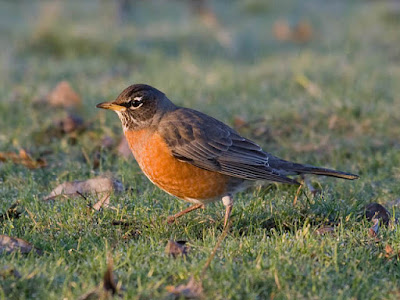 |
| American Robin. Greg Gillson |
Range in Montana: American Robins are year-round residents throughout most of Montana, summer residents only in northeastern Montana.
Identification: This is a key species for comparing with an unknown bird.
Size: 10 inches long from bill tip to tail tip. About the same size as a Blue Jay or one of the Scrub-Jays. Larger than Red-winged Blackbird. Smaller than a Mourning Dove.
Shape: Very plump with a fairly long tail.
Bill: Straight and fairly slender, curved at the tip.
Color: Gray-brown upperparts, rusty orange breast.
Habitat, range & behavior: Open woodlands, farmlands, urban parks and lawns.
Migratory, breeds north across Alaska and Canada. Resident in most of the United States (lower 48). Winters in the United States, Mexico, to central America.
Hops on your lawn turning head this way and that looking for food. Their caroling song is one of the early signs of spring in the north.
Food and feeder preference: Worms and other invertebrates in the lawn. May eat fruit from a tray feeder or the ground. Eat small berries from trees and bushes.
2. Black-billed Magpie (Pica hudsonia)
This large flashy bird with a long tail is a ranchland bird in the West. The only similar bird in North America is the Yellow-billed Magpie of the Central Valley of California.
 |
| Black-billed Magpie. Greg Gillson. |
Range in Montana: Black-billed Magpies are year-round residents throughout Montana.
Identification:
Size: About the size of an American Crow, but with a longer tail.
Shape: Thick neck, large head, strong legs. A very long pointed tail; the distance from the base of the tail to the tip of the tail is nearly as long as from the base of the tail to the tip of the bill. Wings are broad and rounded at the tips.
Bill: Stout, nearly as long as head.
Color: Black head, breast, back. White shoulders and belly. Wings black above with bluish or greenish sheen; most of the primaries are white. Tails is blackish with an iridescent blue-green sheen.
Habitat, range & behavior: Magpies are found in dry open country, ranches, farms, scattered open pine lands and riparian thickets.
They are residents from southern Alaska to the Great Basin and Great Plains to the Dakotas and south to New Mexico.
Fly with slow wing beats and deep wing strokes displaying large white wing patches. Social. Perch on fence posts. Forage on ground. Calls are noisy, raspy, querulous “yak?”
Food and feeder preference: Omnivore as crows, eating carrion, berries, seeds, nuts, human garbage, pet food. Birders generally don’t want this species at their bird feeders. Locals often view these birds as pests.
3. Black-capped Chickadee (Poecile atricapillus)
This is a common backyard bird in the northern half of the United States.
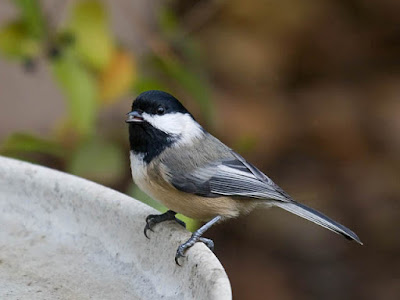 |
| Black-capped Chickadee. Greg Gillson |
Range in Montana: Black-capped Chickadees are year-round residents throughout Montana.
Identification:
Size: Chickadees are small birds, the same general size as an American Goldfinch.
Shape: Round body, big round head, long tail with rounded tip.
Bill: Short, straight, stout.
Color: Gray above, buffy below. Black cap and bib with white lower face. White edges on wing feathers.
Habitat, range & behavior: Deciduous and mixed forests.
They range from the northern half of the United States, southern half of Canada, and most of Alaska.
Small flocks flit actively from tree to tree acrobatically gleaning insects from twig tips. In winter chickadees make up the core of mixed-species flocks also containing nuthatches, kinglets, creepers, woodpeckers and others.
Food and feeder preference: Seeds, insects, berries. They eat at tube, hopper and tray feeders. They love black oil sunflower seeds and suet.
You may like my in-depth article on attracting Black-capped Chickadees.
4. Northern Flicker (Colaptes auratus)
Of all the bird identification questions I get asked, this common larger backyard bird is the bird most people ask about. It doesn’t occur to those unfamiliar with it that this could be a woodpecker.
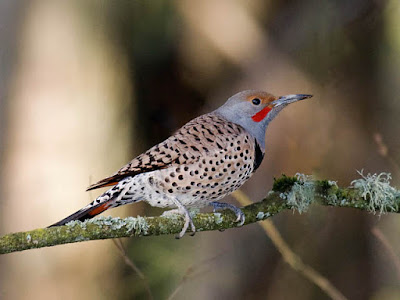 |
| Northern Flicker. Greg Gillson |
Range in Montana: Northern Flickers are year-round residents throughout Montana.
Identification:
Size: About the size of a Mourning Dove. Larger than a robin.
Shape: Stocky with short legs, short tail, big head.
Bill: As long as head, thin, slightly curved.
Color: Back is brown with black bars. Under parts pinkish with black spots. Undersides of black wing and tail feathers are bright salmon red (West) or yellow (East). Head gray (West) or brown (East) and males with red (West) or black (East) whisker marks and nape marks (East). Black crescent across chest. White rump seen in flight.
Habitat, range & behavior: Found in woodland edges and forests.
Year-round resident from extreme southern Canada, across all of the lower-48 states and in the mountains of Mexico and Middle America. In summer breeds northward well into Canada and Alaska.
Frequently noted hopping on ground pecking in the ground for insects. In late spring, males proclaim their territory by rapid pounding on a hollow tree branch, though the ringing of metal downspouts at dawn is louder and carries much farther, to the exasperation of anyone trying to sleep inside!
Food and feeder preference: Ants and beetles are their primary foods. Will eat black oil sunflower seeds and are attracted to suet.
5. European Starling (Sturnus vulgaris)
Introduced to North America in the late 1800’s, they crossed the continent, often to the detriment of native cavity-nesting birds. The prime example of an invasive species.
 |
| European Starling. Greg Gillson |
Range in Montana: European Starlings are year-round residents throughout Montana.
Identification: This is a key species for comparing with an unknown bird.
Size: 8-1/2 inches from bill tip to tail tip. About the size of a Red-winged Blackbird. Smaller than an American Robin. Larger than a White-crowned Sparrow or Spotted/Eastern towhee.
Shape: Stocky with large head, short square-ended tail. Longer legs.
Bill: As long as head. Sharp pointed. Yellow in spring, otherwise dark.
Color: They are grayish brown much of the year, with glossy iridescence and white spotting during the spring.
Habitat, range & behavior: Lowland birds that need trees large enough for nest cavities but plenty of open area for feeding. They are most abundant in urban and suburban areas where they find food and artificial nest cavities.
Resident from coast-to-coast from southern Canada to northern Mexico. In summer north across Canada and Alaska. Native range is Europe to Pakistan, north Africa.
Often viewed as a pest, starlings often bully other backyard birds, taking over bird feeders, and stealing nest cavities from smaller native birds. In winter they can form into flocks of tens of thousands.
Food and feeder preference: Primarily insects when available, often feeding on the ground. Discourage them from your backyard hopper and tray feeders by never feeding birds table scraps (including bread or meat).
They have weak feet and do not perch well on tube feeders. A cage mesh around smaller hopper feeders may keep them out.
6. Red-winged Blackbird (Agelaius phoeniceus)
These noisy flocking birds are most often found in marshes. But in winter they are found in backyards.
 |
| Male Red-winged Blackbird. Greg Gillson. |
 |
| Female Red-winged Blackbird. Greg Gillson. |
Range in Montana: Red-winged Blackbirds are summer residents throughout Montana, year-round residents in southwestern Montana.
Identification: This is a key species for comparing with an unknown bird.
Size: About 8-3/4 inches long from bill tip to tail tip. About the size of a Northern Cardinal. Smaller than an American Robin.
Shape: Pot-bellied with a longer bill and flat forehead. Tail average.
Bill: Long and sharp pointed.
Color: Males are black with red and yellow shoulder patch. Females are streaked brown and rusty (sparrow-like but pointed bill and flat forehead).
Habitat, range, and behavior: Cattail marshes and wetlands are their summer habitat. In winter they feed in grain fields.
They breed across most of the North American continent. In winter they withdraw from most of Alaska and Canada.
They are found in colonies in summer and large flocks in winter.
Food and feeder preference: They eat insects in summer. In winter they eat grain and seeds. They visit feeders, more often in large winter flocks, and eat most seeds and suet.
7. House Finch (Haemorhous mexicanus)
Originally a bird of the West, now found across most of the US. There are other red finches, but these are the ones most likely in residential areas.
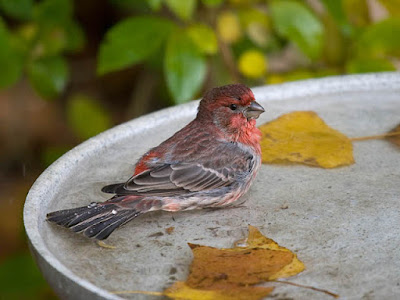 |
| House Finch. Greg Gillson |
Range in Montana: House Finches are year-round residents in central and southeastern Montana.
Identification: This is a key species for comparing with an unknown bird.
Size: About 6 inches from bill tip to tail tip. Larger than goldfinches and chickadees. Smaller than a White-crowned Sparrows or Spotted/Eastern towhees.
Shape: Medium build with a medium-long notched tail. Round head.
Bill: Short, conical.
Color: Brown and gray above with streaks on the sides of the pale underparts. Males with red (sometimes orange or rarely yellow) crown, chest, rump.
Habitat, range & behavior: You’ll find small flocks on wires, in short tree tops and in bushes. Originally deserts and grasslands. Rural areas and towns are where they’re now most common.
Formerly found in the western United States and Mexico. Then introduced into the northeastern United States, but now fou)nd in nearly all of the lower-48 states and extreme southern Canada. Rare in plains states (Dakotas to Texas) and southern Florida.
House Finches are not territorial, but males sing throughout the year–a lively, wiry song ending in a couple of buzzy notes.
Food and feeder preference: They love sunflower seeds and tube feeders. May eat from thistle socks.
You may like my in-depth article on attracting House Finches.
8. House Sparrow (Passer domesticus)
Like the starling, this is another bird introduced from Europe in the 1800’s. This sparrow is commonly found in cities and farmlands. It is considered a pest in most areas where it has been introduced.
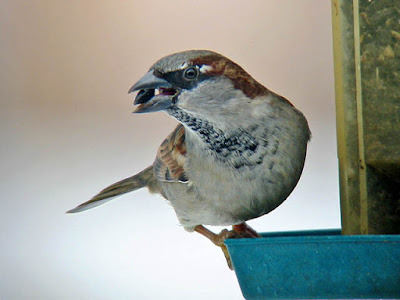 |
| House Sparrow. Greg Gillson |
Range in Montana: House Sparrows are year-round residents throughout Montana.
Identification:
Size: The size of a House Finch or Dark-eyed Junco.
Shape: Chunkier than native North American sparrows with large head, barrel chest, short neck, medium tail, short legs.
Bill: Short, conical.
Color: Males are brown and gray with a black mask. Females lack the black and are tan and brown with a pale line back from the eye.
Habitat, range & behavior: Cities and farms.
Range in North American from southern Canada through Central America. In summer northward through Canada to southern Alaska. Originated in Middle East and spread to most of Europe and Asia. Introduced in South America, Africa, Australia–nearly anywhere there are people and cities.
They tend to be messy… and have a good appetite, and may occur in large noisy chirping flocks. They are aggressive toward other feeder birds.
Food and feeder preference: They eat grain, seed, and insects. To discourage them from your hopper and tray feeders do not feed birds human food scraps. They have a bit of difficulty eating from tube feeders.
9. Eurasian Collared-Dove (Streptopelia decaocto)
These large pale pigeons have only been in the United States since invading Florida in 1983. But they have taken over much of the continent.
 |
| Eurasian Collared-Dove. Greg Gillson. |
Range in Montana: Eurasian Collared-Doves are year-round residents throughout Montana.
Identification:
Size: Large pigeon. Larger than Mourning Dove. Same size as domestic pigeon.
Shape: Full plump breast. Round head. Long square tail.
Bill: Small, blunt.
Color: Cream-colored, may be slightly warmer brown on back or, conversely, may be nearly white. Black hind neck mark. Broad white band at end of tail. From underneath when perched on wire, note the black base to the underside of the tail.
Habitat, range & behavior: These pigeons are found in residential areas and farmlands. Look for them perched on electric lines or in trees.
They are year-round residents in residential areas throughout almost all of the United States, except rare in the Northeast.
A pair of birds nest in one area nearly year-round, then build in numbers over a couple of years. Then several birds from the group fly up to 500 miles and set up a new colony. In this way this species took over much of Europe in the last century, and most of North America, starting from Florida in 1983 (from birds escaped from or vagrant in Bahamas).
Food and feeder preference: Eat grain. Will eat all seeds at bird feeders. Large, hungry, and often visit feeders in groups.
10. Red-breasted Nuthatch (Sitta canadensis)
These small birds are common in conifer groves and mountain forests.
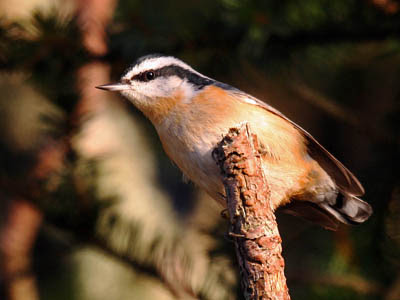 |
| Red-breasted Nuthatch. Greg Gillson. |
Range in Montana: Red-breasted Nuthatches are winter visitors throughout Montana, year-round residents in western and parts of southern Montana.
Identification:
Size: Smaller than Black-capped Chickadees and American Goldfinches, larger than kinglets.
Shape: Compact body with large head on short neck. Stubby tail.
Bill: Fairly long and sharp-pointed.
Color: Dark blue-gray back and upper parts. Black crown and line through eye, showing long white eyebrow. White face and rusty underparts. Females paler.
Habitat, range & behavior: Conifer trees in forests and residential areas.
Found from Alaska and across Canada, mountains of Northeast and much of the West. Winter visitor south throughout most of the United States.
Crawls actively on bark on tree trunks and around smaller branches, often head-first down the tree.
Food and feeder preference: Eat insects and invertebrates. Cache nuts and seeds in fall to eat later in the winter. At feeders eat sunflower seeds, peanuts, other nuts from hopper and tube feeders, and suet.
11. Dark-eyed Junco (Junco hyemalis)
Colloquially called “snowbirds,” they often arrive in backyards in winter from nearby mountain forests or more northern climes.
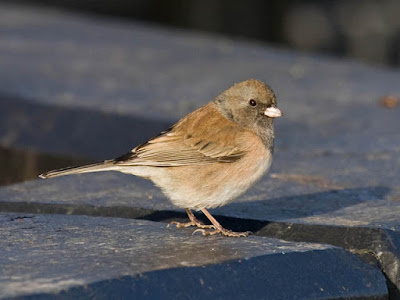 |
| Dark-eyed Junco. Photo by Greg Gillson. |
Range in Montana: Dark-eyed Juncos are year-round residents in western and southern Montana, winter visitors only in northeastern Montana.
Identification:
Size: Small birds about the size of a House Finch.
Shape: Round body, short neck, round head, fairly long square-ended tail.
Bill: Short, pointed, conical, pink.
Color: Eastern birds are a darker all-gray with white belly. Western birds (those breeding in California and pictured above) have jet black hood over head, brown back, white belly and pink sides. Females paler.
Habitat, range & behavior: Breed in coniferous forests. Winters widely. Avoids heavy brush, preferring widely spaced bushes.
Breeds across most of Canada, Alaska, and the western half of the United States. Winters from southern Canada and all of the lower 48-states to extreme northern Mexico.
Spend much of their time hopping and feeding on the ground.
Food and feeder preference: Dark-eyed Juncos eat mostly seeds, also insects in summer. Readily feed at backyard feeders on mixed seeds on hopper or tray feeders and ground.
You may like my in-depth article on attracting Dark-eyed Juncos.
12. Song Sparrow (Melospiza melodia)
A common bird, but variable, and similar to many other streaked brown sparrows.
 |
| Song Sparrow. Greg Gillson. |
Range in Montana: Song Sparrows are summer residents throughout Montana, year-round residents in southwestern Montana.
Identification:
Size: A smaller bird, similar in size to House Finch and juncos. Larger than chickadees and goldfinches. Smaller than White-crowned Sparrows or Spotted/Eastern towhees.
Shape: Plump with round head, long rounded tail.
Bill: Short, conical.
Color: Highly variable in darkness and color saturation across its range (dark rusty to pale gray). Generally gray-brown above with dark brown streaking on back. Complicated head pattern. Streaking on sides and breast converge into dense central breast spot.
Habitat, range & behavior: Thickets, especially near water. Backyard shrubbery.
Resident in western United States, western Canada, coastal southern Alaska, northeastern US. In summer also moves into mid-Canada and northern half of US. In the winter found in most of the US lower-48. Also a population in central Mexico.
Forages on ground, never far from low cover to which they fly if startled.
Food and feeder preference: Song Sparrows feed on seeds and insects near the ground. Will visit hopper and tray feeders for mixed bird seed.
13. American Crow (Corvus brachyrhynchos)
This larger all-black bird is common in cities and country. Its cawing call is familiar to most people.
 |
| American Crow. Greg Gillson |
Range in Montana: American Crows are summer residents throughout Montana, year-round residents in southwestern Montana.
Identification: This is a key species for comparing with an unknown bird.
Size: About 17-1/2 inches long from bill tip to tail tip, though there is much size variation throughout its range. Larger than blackbirds and grackles. Smaller than ravens.
Shape: Thick neck, large head, rather short square-ended tail. Longer legs. In flight has rounded wing tips with each primary feather separated from others forming “fingers.”
Bill: As long as head, thick, black.
Color: Glossy black throughout.
Habitat, range & behavior: They prefer open areas with trees, fields, farms, cities.
They are common across most of the United States lower-48, except in the desert southwest. They move into southern Canada in summer.
They gather in evening communal roosts in large flocks that may number into the thousands and then move out at dawn into the surrounding area.
Food and feeder preference: Omnivorous, they feed on large insects, grain, small mammals, carrion. You probably don’t want these large entirely-black birds in your backyard feeders. So don’t feed table scraps to birds.
14. Tree Swallow (Tachycineta bicolor)
Look for these birds high in the air, or swooping low over the water chasing flying insects.
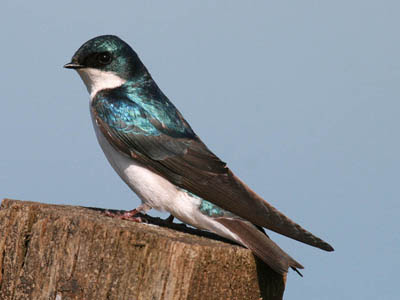 |
| Tree Swallow. Greg Gillson. |
Range in Montana: Tree Swallows are summer residents throughout Montana.
Identification:
Size: These birds are rather small, about the length of American Goldfinches.
Shape: Long body with short tail. Neck short. Wings long and pointed.
Bill: Very short, but wide.
Color: These birds are shiny metallic blue above and bright white below. Males have a black mask.
Habitat, range & behavior: These birds are almost always found near or over water.
They breed in summer across almost all of North America, Alaska across Canada and south throughout all but the dry southwestern deserts and southernmost states of the United States. In winter they are found along southern coastal states, southward into Mexico.
Look for Tree Swallows swooping high or low over ponds, lakes, wetlands.
Food and feeder preference: Tree Swallows chase flying insects and feed on the wing.
15. Western Meadowlark (Sturnella neglecta)
These are beautiful songsters of the prairie grasslands.
 |
| Western Meadowlark. Greg Gillson. |
Range in Montana: Western Meadowlarks are summer residents throughout Montana.
Identification:
Size: Bigger than a European Starling, smaller than an American Robin.
Shape: Stocky and pot-bellied, with short tail and flat forehead profile.
Bill: Long, straight, and sharp pointed.
Color: Straw and brown-colored upper parts. Bright yellow below with black necklace. White outer tail feathers. Duller in winter.
Habitat, range, & behavior: Fields, pastures, prairies.
The summer across the West from the Great Lakes to the Pacific, and western Canada to western Texas, and into Mexico. Move out of Canada in winter and spread to Gulf Coast.
Forage on fields and bare grounds, often found with cattle. In flocks in winter.
Foods and feeder preference: Grain and insects. They do not come to feeders.
16. Mourning Dove (Zenaida macroura)
Mourning Doves are the most widespread and most frequent backyard bird in the Lower 48 states of the United States.
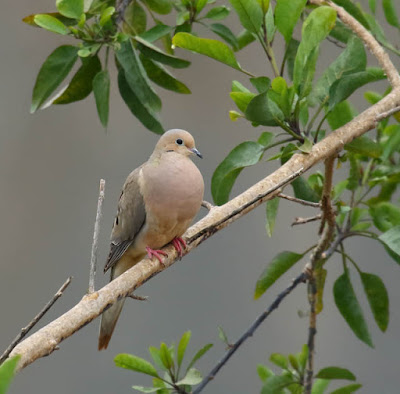 |
| Mourning Dove. Greg Gillson. |
Range in Montana: Mourning Doves are summer residents throughout Montana, year-round residents in parts of western Montana.
Identification: This is a key species for comparing with an unknown bird.
Size: About 12 inches long from bill tip to tail tip. About same size as Northern Flicker. Larger than American Robin. Slightly smaller than domestic city pigeon.
Shape: Very plump with a small round head. Tail is long and pointed. Legs are short.
Bill: Small and rather slender.
Color: Pale brown-pink body, darker wings and tail. White edges on side of tail.
Habitat, range & behavior: Semi-open areas such as urban areas, farmlands, woods. Often seen perched on wires, fences.
It is a resident across the lower-48 states and Mexico, with some movement out of northern areas in winter.
Their mournful cooing is a familiar spring birdsong.
Food and feeder preference: Mourning Doves eat seeds almost exclusively. Attract with black oil sunflower seeds on a large sturdy tray feeder or on the ground.
17. Pine Siskin (Spinus pinus)
These are streaky goldfinch-like birds. Often found in flocks. Irregularly, following a poor cone crop in the north, they move far south in winter, showing up well south of their usual winter range.
 |
| Pine Siskin. Greg Gillson |
Range in Montana: Pine Siskins are winter visitors throughout Montana, year-round residents in western Montana.
Identification:
Size: Tiny bird, the size of American Goldfinch. Smaller than other finches and sparrows.
Shape: Small round head. Short forked tail.
Bill: Short. Wide at the base, straight and sharply pointed.
Color: Heavily streaked with brown. Wing bars. Patches of yellow in wing and base of tail. Much individual variation from dull brown to brighter yellow.
Habitat, range, & behavior: Montane forests, conifer, birch, alder. Lowlands in winter.
Summers across Canada and the West into Mexico. Also breed from Midwest to Northeast states bordering Canada. Winters from southern Canada and throughout the United States, but varying in numbers from year-to-year in southern portions.
Feed in tree tops, often in large swirling flocks.
Food and feeder preference: Eat cone seeds. Love black oil sunflower seeds from tube feeder. Love Niger seed at thistle feeders.
18. Mountain Chickadee (Poecile gambelli)
These chickadees are found in mountain forests of the West.
 |
| Mountain Chickadee. Greg Gillson. |
Range in Montana: Mountain Chickadees are year-round residents in western Montana and isolated mountains throughout.
Identification:
Size: Small birds, smaller than finches and sparrows.
Shape: Round fluffy body. Large round head. Long penduline tail. Strong legs and feet.
Bill: Short and stout.
Color: Gray with black crown and throat. White eyebrow line.
Habitat, range, & behavior: Found in mountain pine forests.
Western Canada and the United States in pine forests at high elevations.
Feed in small straggling flocks. Acrobatically hang from tips of twigs to feed.
Food and feeder preference: Beetles and other insects, seeds. Readily come to hopper feeders for black oil sunflower seeds.
19. American Goldfinch (Spinus tristis)
A beautiful tiny finch familiar to many in it’s bright yellow summer plumage. Colloquially called a “wild canary.”
 |
| American Goldfinch. Greg Gillson |
Range in Montana: American Goldfinches are summer residents throughout Montana, year-round residents in western Montana.
Identification: This is a key species for comparing with an unknown bird.
Size: Very small at about 5 inches from bill tip to tail tip. Similar in size to a chickadee. Larger than hummingbirds. Smaller than juncos and House Finches.
Shape: Tiny, somewhat plump with larger head and short tail.
Bill: Short, conical, pink.
Color: Males in summer are bright lemon yellow with black forehead and black wings and tail with white bars. White under tail coverts. Females dull olive, wings and tail browner. Winter birds are pale grayish-yellow with tan and brown wings and tail.
Habitat, range & behavior: This species is found in weedy fields and similar clearings with thistles and similar plants.
It is found coast-to-coast throughout the year across most of the middle lower-48 states. In summer moves north to the Canada border. In the winter found south to the Mexico border.
The flight is highly undulating, rising and falling as they flap in short bursts.
Besides a long, sweet lilting song, they call in flight a lilting 4-part: “potato chip!”
Food and feeder preference: Feeds on weed seeds, thistle seed. May eat black oil sunflower seeds from tube feeder. Love Nyjer seed in a feeder called a “thistle sock.”
You may like my in-depth article on attracting American Goldfinches.
20. Yellow-rumped Warbler (Setophaga coronata)
An abundant warbler to treetops and weedy areas.
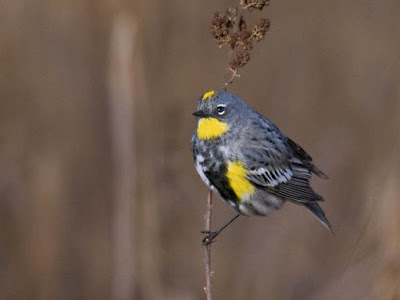 |
| Yellow-rumped Warbler. Greg Gillson. |
Range in Montana: Yellow-rumped Warblers are summer residents in western and southern Montana, spring and fall migrants throughout.
Identification:
Size: Small, they are a bit larger than chickadees and goldfinches. They are smaller than House Finches and juncos.
Shape: Plump and neckless with a shorter tail.
Bill: Short, slender, straight, pointed.
Color: Breeding plumage in spring is blue-gray on the upper parts, black sides and chest, yellow rump, yellow on sides. Two forms: western form with yellow throat and large white wing patch; eastern and northern form with white throat and two white wing bars. In winter plumage both forms are gray brown above, pale cream below. Yellow rump and white tail corners in flight.
Habitat, range & behavior: In breeding season mostly in coniferous or mixed forests, in mountains in west. In winter open areas with fruiting shrubs and scattered trees.
Breed across Canada and Alaska and in conifer forests in the west. Winter along both coasts and the southern states through Middle America. There are also non-migratory forms in Mexico and Guatemala.
They tend to forage in outer branches about half way up the tree.
Food and feeder preference: Yellow-rumped Warblers eat mainly insects in the summer. They switch to waxy berries and fruit in winter. They are thus able to winter farther north than other warblers. They are attracted to suet feeders.
21. Rock Pigeon (Columba livia)
These pigeons are especially common in urban settings. They are also known as Rock Doves or domestic pigeons.
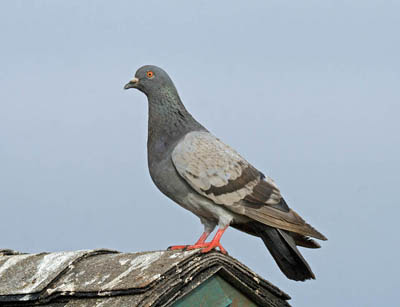 |
| Rock Pigeon. Greg Gillson. |
Range in Montana: Rock Pigeons are year-round residents throughout Montana.
Identification:
Size: Larger than a Mourning Dove.
Shape: Large chest. Small round head. Pointed wings. Squared tail.
Bill: Short and fairly thin, with bump on nostril.
Color: Variable; may be white, rusty, or pied. “Wild” coloration has a blue-gray body with iridescent sheen on throat. Paler gray wings with two dark broad wing bars. Tail with dark band. White rump.
Habitat, range, & behavior: City streets, building ledges, and commercial parking lots; farms.
Resident across Canada, all of the United States, south into Mexico. Worldwide distribution.
Often seen perched on roofs and ledges in cities. Walk on sidewalks picking up scraps of food garbage dropped by humans.
Food and feeder preference: Eat grain and corn, and human food scraps, especially French fries and other fast food garbage. May eat just about any food at platform and larger hopper feeders.
22. Downy Woodpecker (Dryobates pubescens)
This tiny woodpecker is found across the United States.
 |
| Downy Woodpecker. Greg Gillson |
Range in Montana: Downy Woodpeckers are year-round residents throughout Montana.
Identification:
Size: Bigger than a junco or House Finch. Smaller than a Red-winged Blackbird. About the same size as a White-crowned Sparrow, but with a much shorter tail.
Shape: Stocky with large head and short stiff tail.
Bill: Short, chisel-shaped.
Color: Black-and-white striped head. Black wings with white spots. Solid white back. White under parts. Black tail with white outer tail feathers with black bars or spots. Male with small red spot at back of head.
Habitat, range & behavior: Found in small deciduous trees, willows, and even weed stocks such as teasel, especially near water.
Ranges coast-to-coast across all but northernmost parts of Canada and Alaska south to the southern US. Absent in the desert southwest.
Interestingly, I learned today that the males may more often be found in smaller plants and twigs, while females are more likely on tree trunks.
Food and feeder preference: Insects, fruits, and seeds. Gleans arthropods from the bark of trees. Attract with suet feeder. Will also eat black oil sunflower seeds.
23. Brown-headed Cowbird (Molothrus ater)
Cowbirds are small blackbirds lay their eggs in the nests of other smaller birds, such as warblers. The adoptive parents raise their young!
 |
| Brown-headed Cowbird. Greg Gillson. |
Range in Montana: Brown-headed Cowbirds are summer residents throughout Montana.
Identification:
Size: Larger than White-crowned Sparrows, but smaller than Rose-breasted or Black-headed Grosbeaks. Smaller than other blackbirds, starlings, and grackles.
Shape: Perhaps a little bit pot-bellied. Medium length tail. Flat forehead as typical for blackbirds.
Bill: Rather thick and stout.
Color: Males are glossy black with rich brown head. Females are dusty gray-brown throughout. Long-held juvenile plumage similar to pale female, scaly, being fed by Yellow Warbler or Song Sparrow or a hundred other host species.
Habitat, range & behavior: They are found in woodlands and farms. Also with other blackbirds in winter at shopping center parking lots.
In summer they breed across Canada and most of the United States and Mexico. In winter they move south out of Canada and occupy both coasts and southeastern States in the US.
These small blackbirds join other flocks of blackbirds in cattle feedlots. You may see cowbirds riding on the backs of cattle, sheep, or horses. They originally rode on the backs of American bison on the Great Plains, but expanded when forests were cut.
Food and feeder preference: Cowbirds eat grains, seeds, and insects. They will readily come to hopper and platform feeders. They are larger and more aggressive, so keep other birds from feeders and have a big appetite!
24. Cedar Waxwing (Bombycilla cedrorum)
Waxy red tips to the wing feathers give these birds their unique name. Maybe it’s the fancy crest. Maybe it’s the bandit mask. Maybe it’s the yellow band at the tip of its tail. But these are one of my favorite birds.
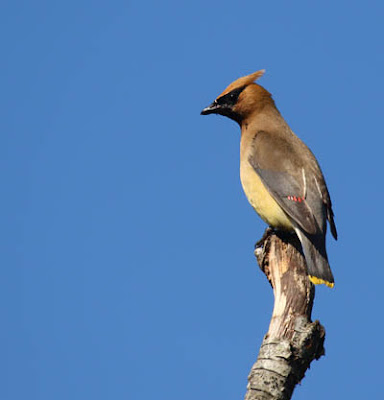 |
| Cedar Waxwing. Greg Gillson. |
Range in Montana: Cedar Waxwings are year-round residents throughout Montana.
Identification:
Size: Smaller than European Starling. Larger than House Sparrow.
Shape: Similar to European Starling. Rather stocky. Short squared tail, but long under tail coverts. Large head. Pointed wings. Wispy crest.
Bill: Rather short, small, wide.
Color: Warm brown above with wispy crest. Black mask. Yellowish belly. White under tail coverts. Gray wings. Gray tail with yellow tip.
Habitat, range, & behavior: Deciduous woods, wooded streams and lakeshores, residential shade trees, fruit orchards.
Resident across the northern US. Summer resident in Canada. Winter visitor throughout all of US and Mexico.
Keep in tight flocks. Feed in trees and large bushes for berries. Fly catch over ponds and streams.
Food and feeder preference: Berries and flying insects. Usually don’t come to feeders unless fruit like cherries offered, but will visit bird baths.
25. Chipping Sparrow (Spizella passerina)
Chipping Sparrows are a widespread species adapted to human disturbance. They are rather tame. They are frequently found in cemeteries with large trees.
 |
| Chipping Sparrow. Greg Gillson. |
Range in Montana: Chipping Sparrows are summer residents throughout Montana.
Identification:
Size: These are small sparrows, bigger than goldfinches or chickadees, but smaller than House Finches or Song Sparrows.
Shape: Plump and fairly long-tailed.
Bill: Short and conical.
Color: Striped brown and dark brown above. Grayish under parts. Black line through eye. Crown streaked in winter but in summer becomes solid chestnut. Two white wing bars.
Habitat, range & behavior: Grassy open conifer woodlands with some shrubs, parks, orchards.
Breeds from Alaska, across Canada and south into highlands of Middle America. In winter retreats from northern areas to southern United States and northern Mexico.
In summer solitary or in pairs. In winter they forage in flocks of up to 50 birds.
Food and feeder preference: Weed seeds, supplemented with insects in summer. They may eat black oil sunflower seeds in your feeder, but more likely will feed on mixed seeds on the ground under the feeder.
26. Eastern Kingbird (Tyrannus tyrannus)
These birds often build nests in trees that overhang streams.
 |
| Eastern Kingbird. Greg Gillson. |
Range in Montana: Eastern Kingbirds are summer residents throughout Montana.
Size: About the size of a Red-winged Blackbird. Smaller than a robin.
Shape: Fairly sleek. Perches upright with big puffy head, full tail.
Bill: Fairly long, wide at base,
Color: Black head. Black tail with white band at tip. Dark gray upper parts. White under parts.
Habitat, range & behavior: Farms, clearings in woodlands.
Found across Canada and in the United States east from the Rocky Mountains.
These birds perch on fence lines, tips of small trees. Sally out and snatch flying insects and return to perch.
Food and feeder preference: They eat insects and do not come to feeders.
27. Western Wood-Pewee (Contopus sordidulus)
These birds sing their burry pee-wee, pee-year song into summer and throughout the day.
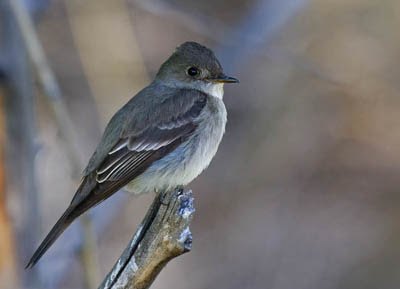 |
| Western Wood-Pewee. Greg Gillson. |
Range in Montana: Western Wood-Pewees are summer residents throughout Montana.
Identification:
Size: Just slightly bigger than a House Finch.
Shape: Large head and big chest, long wings and tail. Upright posture.
Bill: Medium length compared to head, but wide at base and flat. Mostly dark, with a touch of yellow-orange at base of lower mandible.
Color: A dull gray-green-brown. Two broad pale wing bars. Under parts pale with grayish sides, often show yellow on the belly when in shade.
Habitat, range & behavior: A bird of open woodlands.
Summer resident from Alaska, western Canada, western United States and into Mexico. Winters in South America.
These larger flycatchers sit motionless on tip of dead branch, then fly out to snap up a flying insect, then return to their original perch again.
Food and feeder preference: Feed on flying insects. Do not come to feeders.
Common Birds in Montana
To determine how common each species is I used the data from actual bird sightings from the citizen science program eBird. Birds are listed by frequency. That is, how often the species is recorded on checklists submitted to eBird (a percentage).
When choosing the birds to include in this article I leaned strongly to birds that are present throughout the year in good numbers. Thus, many of the common birds are year-round residents. This means that they live in the same location all year. They raise their young in your neighborhood. They don’t migrate. Or if the species does migrate, the ones living in your area don’t. If this is the case, some migrants may move into your area during certain times of year, adding to the same species that are in your yard full time.
Some migrant birds visit your yard during the “summer.” Often, they arrive in spring and remain until late fall. They nest and raise their young in your neighborhood. These are the summer residents.
Other migrant birds visit your backyard during the “winter.” Some of these winter visitors may arrive in July and remain into April. Others may only be found in the cold of December or January. They key here is that they nest and raise their young somewhere else. They only visit your yard in the non-breeding season.
Migration is an amazing spectacle.
There will be birds that fly through your region in spring or fall (or both). They may visit your backyard only a few days or weeks a year. They aren’t regular enough, or stay long enough, to be included in this article. But the number of briefly visiting migrant birds could double the number of species presented here. You may see them over time. Consult checklists in eBird for your county to see what is possible.
I have generally excluded common waterfowl, birds of prey, shorebirds, seabirds, and others that aren’t usually found in residential areas. But they may certainly fly over or be seen regularly if your home is on a shoreline, for instance.
Most common backyard birds in Montana throughout the year
The following list is the backyard birds that are, on average, most common throughout the entire year. The list is ordered by most common based on the frequency of how often each species is recorded on checklists submitted to eBird.
- American Robin (39% frequency)
- Black-billed Magpie (37%)
- Black-capped Chickadee (32%)
- Northern Flicker (31%)
- European Starling (26%)
- Red-winged Blackbird (24%)
- House Finch (21%)
- House Sparrow (19%)
- Eurasian Collared-Dove (17%)
- Red-breasted Nuthatch (17%)
- Dark-eyed Junco (17%)
- Song Sparrow (16%)
- American Crow (16%)
- Tree Swallow (15%)
- Western Meadowlark (15%)
- Mourning Dove (15%)
- Pine Siskin (14%)
- Mountain Chickadee (13%)
- American Goldfinch (12%)
- Yellow-rumped Warbler (12%)
- Rock Pigeon (12%)
- Downy Woodpecker (12%)
Most common backyard birds in Montana in winter
- Black-billed Magpie (49% frequency)
- Black-capped Chickadee (42%)
- Northern Flicker (33%)
- House Finch (26%)
- House Sparrow (25%)
- Eurasian Collared-Dove (20%)
- Downy Woodpecker (18%)
- Red-breasted Nuthatch (18%)
- Mountain Chickadee (18%)
- Dark-eyed Junco (17%)
Most common backyard birds in Montana in summer
- American Robin (58% frequency)
- Red-winged Blackbird (32%)
- Tree Swallow (29%)
- Northern Flicker (26%)
- Mourning Dove (25%)
- Black-billed Magpie (25%)
- Western Meadowlark (24%)
- Brown-headed Cowbird (24%)
- Pine Siskin (24%)
- European Starling (22%)
- Cedar Waxwing (22%)
- Chipping Sparrow (21%)
- Eastern Kingbird (20%)
- Western Wood-Pewee (21%)
- Song Sparrow (20%)
- Black-capped Chickadee (20%)
American Robins, Red-winged Blackbirds, Tree Swallows, Mourning Doves, Western Meadowlarks, Brown-headed Cowbirds, Pine Siskins, Cedar Waxwings, Chipping Sparrows, Eastern Kingbirds, Western Wood-Pewees are more common in Montana in summer than in winter.
Black-billed Magpies, Black-capped Chickadees are more common in winter than summer in Montana.
Common Backyard Birds of Billings, Montana
 |
| Eurasian Collared-Dove. Greg Gillson |
- American Robin (49% frequency)
- Black-capped Chickadee (47%)
- European Starling (46%)
- House Finch (41%)
- Northern Flicker (35%)
- Eurasian Collared-Dove (33%)
- House Sparrow (30%)
- Mourning Dove (30%)
- Red-winged Blackbird (26%)
- Rock Pigeon (24%)
- Black-billed Magpie (23%)
- American Crow (22%)
- Downy Woodpecker (21%)
As expected in a large state with few cities, American Robins, Black-capped Chickadees, European Starlings, House Finches, Eurasian Collard-Doves, House Sparrows, Mourning Doves, Rock Pigeons are more common in Billings than in the state as a whole.
Black-billed Magpies are less common in Billings than in the state as a whole, on average.
Common Backyard Birds of Missoula, Montana
- Northern Flicker (49% frequency)
- Black-capped Chickadee (47%)
- American Robin (42%)
- Black-billed Magpie (39%)
- House Finch (31%)
- Song Sparrow (28%)
- European Starling (28%)
- American Crow (28%)
- Red-breasted Nuthatch (27%)
- House Sparrow (27%)
- Dark-eyed Junco (22%)
- Eurasian Collared-Dove (19%)
Northern Flickers, Black-capped Chickadees, House Finches, Song Sparrows, American Crows, Red-breasted Nuthatches are more common in Missoula than the average for the state as a whole.
Common Backyard Birds of Great Falls, Montana
- European Starling (34% frequency)
- Black-capped Chickadee (32%)
- American Robin (32%)
- Black-billed Magpie (32%)
- House Sparrow (27%)
- House Finch (25%)
- Red-winged Blackbird (24%)
- Mourning Dove (23%)
- Rock Pigeon (23%)
The birds in Great Falls are similar in commonness to the state average with these exceptions:
Rock Pigeons are more common in Great Falls than the state average.
Northern Flickers are less common in Great Falls than the state average.
Common Backyard Birds of Bozeman, Montana
- Black-billed Magpie (65% frequency)
- American Robin (46%)
- Black-capped Chickadee (44%)
- Northern Flicker (32%)
- European Starling (32%)
- House Finch (28%)
- Red-winged Blackbird (27%)
- House Sparrow (27%)
- Mountain Chickadee (23%)
- American Crow (20%)
- Pine Siskin (19%)
- Eurasian Collared-Dove (19%)
- Dark-eyed Junco (18%)
- Song Sparrow (18%)
- Downy Woodpecker (17%)
Black-billed Magpies, Black-capped Chickadees, Mountain Chickadees are more common in Bozeman than in the state as a whole, on average.
Wrapping Up
From the majestic peaks of the Rocky Mountains to the vast grasslands of the eastern plains, each habitat offers a unique birding experience. So if you venture further from your backyard, here are some more common birds you might encounter.
Open Country Birds:
- Western Meadowlark: This grassland songbird with its bright yellow breast and black bib is the state bird of Montana. Its melodious song is a familiar sound of the prairies.
- Red-winged Blackbird: These bold blackbirds with their bright red epaulets are common in marshes, fields, and backyards. They’re vocal birds with a variety of calls and songs.
- American Kestrel: This small falcon is a common sight hovering over fields and meadows in Montana. It hunts for insects and small rodents, using its keen eyesight to spot prey from above.
- Rock Pigeon: These introduced birds are found in cities and towns throughout Montana. They’re often seen perched on buildings and foraging for food scraps.
Mountain Birds:
- Common Raven: These intelligent birds with their black plumage and raspy calls are found in a variety of habitats in Montana, including mountains, forests, and even cities. They’re opportunistic feeders and scavengers.
- Clark’s Nutcracker: This large, crow-sized bird with a white wing patch is a common sight in the mountains of Montana. It feeds on pine nuts and other seeds, storing them in caches for later.
- Mountain Bluebird: These stunning birds with their bright blue plumage and orange bellies are found in open forests and meadows in the mountains of Montana. They feed on insects and berries.
This is just a small sampling of the many common birds you can find in Montana. With its varied habitats and abundant birdlife, Montana is a birder’s paradise. So next time you’re in the Big Sky Country, keep your eyes peeled and ears open, and you’re sure to see some amazing birds!
Frequently Asked Questions
What is the state bird of Montana?
The state bird of Montana is the Western Meadowlark! This beautiful songbird with its bright yellow breast and black bib is a cherished symbol of the state’s vast grasslands and prairies. Its cheerful melody, often described as a rich, warbling whistle, is a familiar sound throughout Montana. The Western Meadowlark was even chosen as the state bird in 1931 by a popular vote among Montana schoolchildren, making it an even more significant representation of the state’s spirit and natural beauty.
What are the black and white bird in Montana called?

Black-and-white Warblers are most commonly found in mature deciduous forests and mixed coniferous-deciduous forests in Montana. They particularly favor areas with abundant dead trees and fallen logs, as they forage for insects on and under the bark. You might also have luck finding them in riparian areas along streams and rivers.
Here are some specific places you can try:
- Flathead National Forest: This large forest in northwestern Montana provides excellent habitat for Black-and-white Warblers. Look for them in mature deciduous forests, especially near edges and clearings.
- Glacier National Park: The park’s mountains and forests offer a variety of habitats for Black-and-white Warblers. Look for them along trails in wooded areas.
- Yellowstone National Park: The park’s lodgepole pine forests and riparian areas provide good habitat for Black-and-white Warblers. Look for them near streams and in mature forests.
- R-Lake National Recreation Area: This area near Missoula offers a mix of forest types, including deciduous forests that are good habitat for Black-and-white Warblers. Look for them along trails and near water.
Remember, Black-and-white Warblers are migratory birds, so they will only be present in Montana during the breeding season, which is typically from late April to early September.
What is the red breasted bird in Montana?
Here are some examples of red-breasted birds commonly found in Montana:
- American Robin: These familiar songbirds have a bright rusty-red breast, black head and back, and a white throat. They’re found in a variety of habitats, including forests, backyards, and open fields.
- Red-breasted Nuthatch: These small, acrobatic birds have a rusty-orange breast, gray back, and black cap. They’re commonly seen in coniferous forests, where they climb trees and tap on bark to extract insects.
- Western Tanager: These medium-sized birds have a bright red breast, black wings and head, and yellow wings. They’re found in coniferous forests and mountain meadows, often near streams.
- Northern Flicker: This large woodpecker has a yellow breast, black bib, and barred back. While most commonly seen on tree trunks, it can sometimes be spotted on the ground foraging for insects.
- Red-breasted Merganser: These diving ducks have a rusty-red breast, black body, and green head. They’re primarily found on lakes and rivers, where they feed on fish.
Related Articles:
34 of the most common birds in the United States (with photos)











I did not see any photos of Clark’s Nutcrackers which visit my Crazy Mountain Montana feeders daily. I have some photos and videos if you would like to see them. A retired forest service ranger told me they were rare but I have had as many as 7 at one time but usually just 2-3.
Now that's a bird few people have at their feeders! I totally believe, you. And you must be way up high.
Clark's Nutcrackers are recorded on less than 6% of the bird checklists submitted for Montana. You are in a special area!
Because of your high elevation, you are going to have many backyard birds different from those backyards farther down in lower towns.
I hiked the forest to a burn up above a ski resort in the Washington Cascades to see Clark's Nutcrackers last year. One of my favorite places to see them is at Crater Lake National Park in Oregon. Again, 5000 feet or higher.
Thanks for sharing.